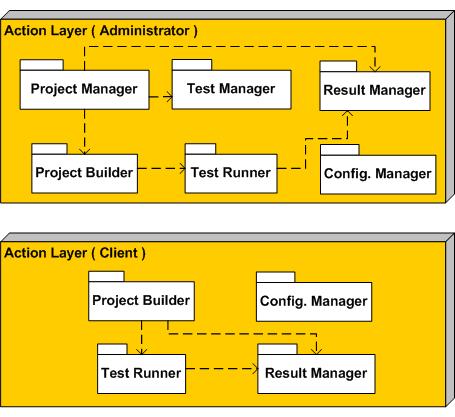
There is only one module in the GUI layer. This module only communicates with the modules in the action layer. In the design specification [Johansson, 2003], a number of classes representing the screens in appendix B will be identified.
The action layer is the core of Audio Jury. It is here that almost all requirements are fulfilled. See section 3.2. Fulfilment of requirements for details.
This is a high-level interface that covers use cases like Create Project, Edit Project, Save Project, Delete Project, Activate Project, Close Project, Duplicate Project and Run Project.
This module operates on a single project. It contains operations for editing and building up a project.
This module's task is to run a test opened by Project Builder module and also to collect test results during the test. When the test is finished results are passed to Result Manager.
When the whole project is finished all results from all tests in the project are saved by Result Manager.
This module's task is to collect incremental results while the project is being run. When the project is finished Result Manager will pass all results from the tests to Result Proxy.
This module represents a high-level service for managing system configuration for both administrator and client programs.
Physical implementation, how and where to store configuration information, is delegated to Configuration Proxy module. It provides a service for the proxy level modules Storage Proxy and Result Proxy, when they need configuration information.
This module will implement the procedures for accessing and storing projects and tests in the shared folder.
This module acts as a proxy between the action layer and the API layer for playing sounds. It does not implement the sound playing function, rather it just provides an interface. It relies on sound playing functionality in the API layer.
This module provides system input and output through data streams, serialization and the file system.
The connections between layers and the dependencies between modules described in sections 4.1 - 4.4 will below be shown graphically.
Use case and module diagrams presented in chapter 3 and sections 4.1 - 4.5 show the static aspects of the system. Modules are not static components, they interact with one another, accomplishing a particular use case. Diagrams, that show how modules communicate, help more clearly understanding responsibilities of the modules and will be used during the design phase.
Activity diagrams have been chosen as method to represent communication between modules. Interaction diagrams will be used in the design to show interaction between objects.
|
Quadralay Corporation http://www.webworks.com Voice: (512) 719-3399 Fax: (512) 719-3606 sales@webworks.com |